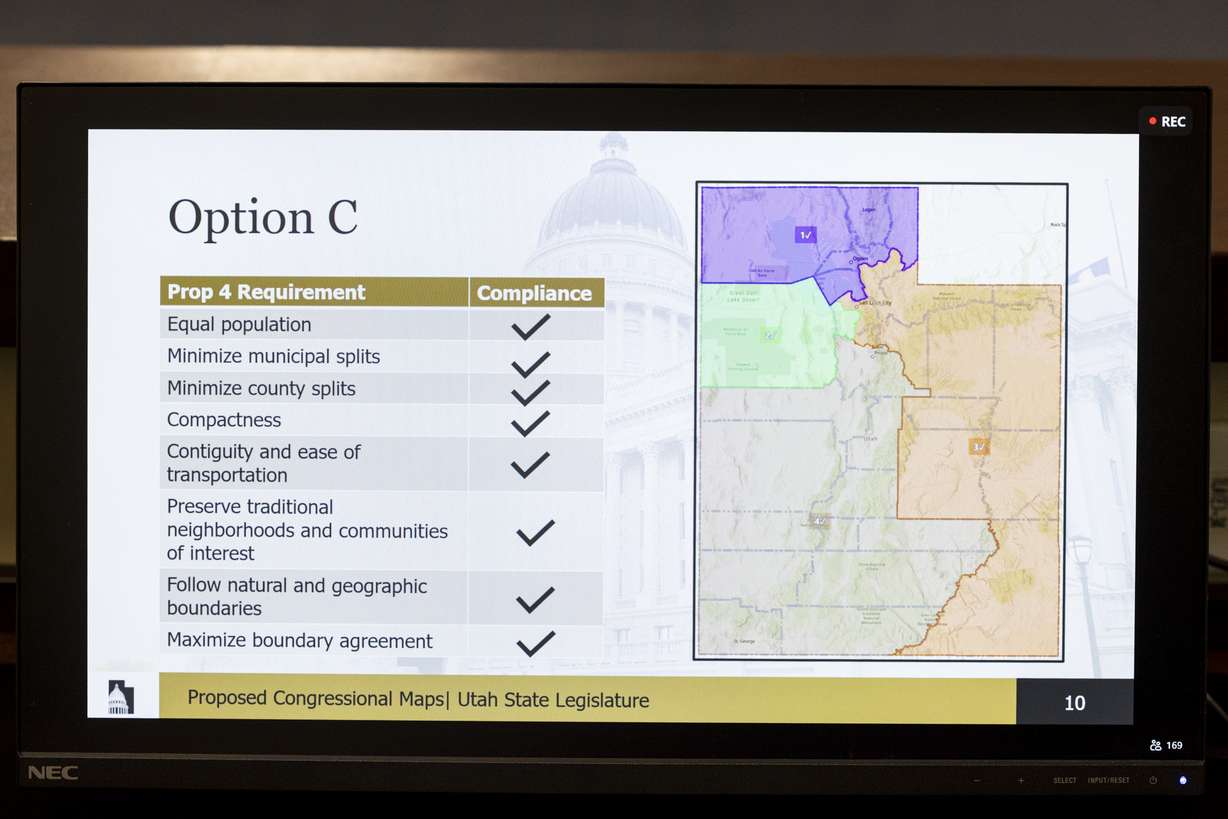SALT LAKE CITY — A judge has thrown out a new U.S. congressional map passed by the Republican-led Legislature in favor of an alternative map.
The map has the potential to reshape Utah’s representation in the U.S. House of Representatives, as at least two of the four congressional districts are significantly more competitive than the current map, which gives Republicans strong advantages in each district.
Lawmakers approved the current map, which heavily favors the GOP, in 2021. The approval of the new map is expected to draw interest from Democrats who now have a realistic chance at winning, including former Rep. Ben McAdams, the last Utah Democrat to serve at the federal level before losing to Rep. Burgess Owens in 2020.
State Sen. Kathleen Riebe, D-Cottonwood Heights, has also said she’s considering throwing her hat in the ring after running in a special election to replace former Rep. Chris Stewart in 2023.
In a decision late on Monday night, District Judge Dianna Gibson called the legislative map an “extreme partisan outlier” that illegally gave Republicans an advantage. The Republican-drawn plan split Salt Lake County, where most of the state’s Democrats reside, in half.
“Based on the evidence presented, the court finds that Map C was drawn with the purpose to favor Republicans,” she wrote.
Republican state lawmaker Candice Pierucci, who helped lead the Legislature’s map drawing, called the decision “a clear example of judicial activism” on X.
Democratic U.S. Rep. Suzan DelBene, the chair of the party’s national congressional campaign arm, said in a statement, “This ruling is a victory for every Utahn who believes voters — not politicians — should decide who their representatives are.”

Monday’s ruling provides some certainty about what the 2026 congressional elections will look like, but it’s only the latest development in a years-long fight over who gets to draw political boundaries in the state and how. The saga goes back to 2018, when voters approved Proposition 4 to establish an independent redistricting commission and standards for drawing nonpartisan maps.
Lawmakers reached a compromise with the organizers of that ballot initiative and replaced it in 2021, making the commission’s role advisory. It then ignored the commission’s recommendations and adopted its own maps, splitting Salt Lake County voters into all four districts and making every seat all but unwinnable for Democrats.
Plaintiffs sued the Legislature in 2022, arguing that the maps were an illegal partisan gerrymander and that lawmakers violated the people’s power by repealing and replacing Proposition 4. The state Supreme Court agreed that lawmakers had overstepped their authority and sent the issue back to the district court.
Judge Gibson threw out the current map in August, saying it stemmed from an unconstitutional act, and told lawmakers to draw new maps, which they begrudgingly did. Lawmakers have said they will continue to appeal Gibson’s ruling, and the Utah Republican Party has launched an initiative to repeal Proposition 4 altogether.
The plaintiffs still took issue with the new map, approved by lawmakers in October, and amended their earlier complaint to challenge the new map and an accompanying law that set standards for evaluating the fairness of the maps. Plaintiffs said they don’t accurately measure partisan symmetry in a state like Utah, and that would allow the Legislature to draw maps that disfavor Democrats.
Over several days of lengthy hearings, their attorneys argued that the Legislature’s map represented a partisan outlier and that the expert who designed maps for lawmakers used an online tool with access to partisan data, in violation of Proposition 4’s requirements.
The plaintiffs also submitted a pair of maps to the judge for consideration, which they argue better comply with the standards in Proposition 4.
But attorneys for the Legislature insisted that because the Constitution gives lawmakers authority to draw maps, the judge couldn’t pick one of the plaintiffs’ maps over the one approved by lawmakers. They also pushed back on claims that their map doesn’t fit the criteria, with attorney Tyler Green saying: “The Legislature has every reason to think that it has done what it was supposed to do.”
Contributing: Reuters
The Key Takeaways for this article were generated with the assistance of large language models and reviewed by our editorial team. The article, itself, is solely human-written.
Source link

